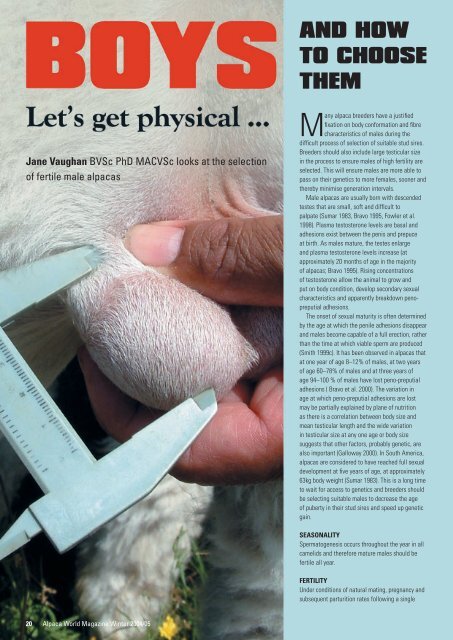Create successful ePaper yourself
Turn your PDF publications into a flip-book with our unique Google optimized e-Paper software.
Jane Vaughan BVSc PhD MACVSc looks at the selection<br />
of fertile male alpacas<br />
20 Alpaca World Magazine <strong>Winter</strong> 2004/05<br />
AND HOW<br />
TO CHOOSE<br />
THEM<br />
Many alpaca breeders have a justifi ed<br />
fi xation on body conformation and fi bre<br />
characteristics of males during the<br />
diffi cult process of selection of suitable stud sires.<br />
Breeders should also include large testicular size<br />
in the process to ensure males of high fertility are<br />
selected. This will ensure males are more able to<br />
pass on their genetics to more females, sooner and<br />
thereby minimise generation intervals.<br />
Male alpacas are usually born with descended<br />
testes that are small, soft and diffi cult to<br />
palpate (Sumar 1983, Bravo 1995, Fowler et al.<br />
1998). Plasma testosterone levels are basal and<br />
adhesions exist between the penis and prepuce<br />
at birth. As males mature, the testes enlarge<br />
and plasma testosterone levels increase (at<br />
approximately 20 months of age in the majority<br />
of alpacas; Bravo 1995). Rising concentrations<br />
of testosterone allow the animal to grow and<br />
put on body condition, develop secondary sexual<br />
characteristics and apparently breakdown penopreputial<br />
adhesions.<br />
The onset of sexual maturity is often determined<br />
by the age at which the penile adhesions disappear<br />
and males become capable of a full erection, rather<br />
than the time at which viable sperm are produced<br />
(Smith 1999c). It has been observed in alpacas that<br />
at one year of age 8–12% of males, at two years<br />
of age 60–78% of males and at three years of<br />
age 94–100 % of males have lost peno-preputial<br />
adhesions ( Bravo et al. 2000). The variation in<br />
age at which peno-preputial adhesions are lost<br />
may be partially explained by plane of nutrition<br />
as there is a correlation between body size and<br />
mean testicular length and the wide variation<br />
in testicular size at any one age or body size<br />
suggests that other factors, probably genetic, are<br />
also important (Galloway 2000). In South America,<br />
alpacas are considered to have reached full sexual<br />
development at fi ve years of age, at approximately<br />
63kg body weight (Sumar 1983). This is a long time<br />
to wait for access to genetics and breeders should<br />
be selecting suitable males to decrease the age<br />
of puberty in their stud sires and speed up genetic<br />
gain.<br />
SEASONALITY<br />
Spermatogenesis occurs throughout the year in all<br />
camelids and therefore mature males should be<br />
fertile all year.<br />
FERTILITY<br />
Under conditions of natural mating, pregnancy and<br />
subsequent parturition rates following a single







